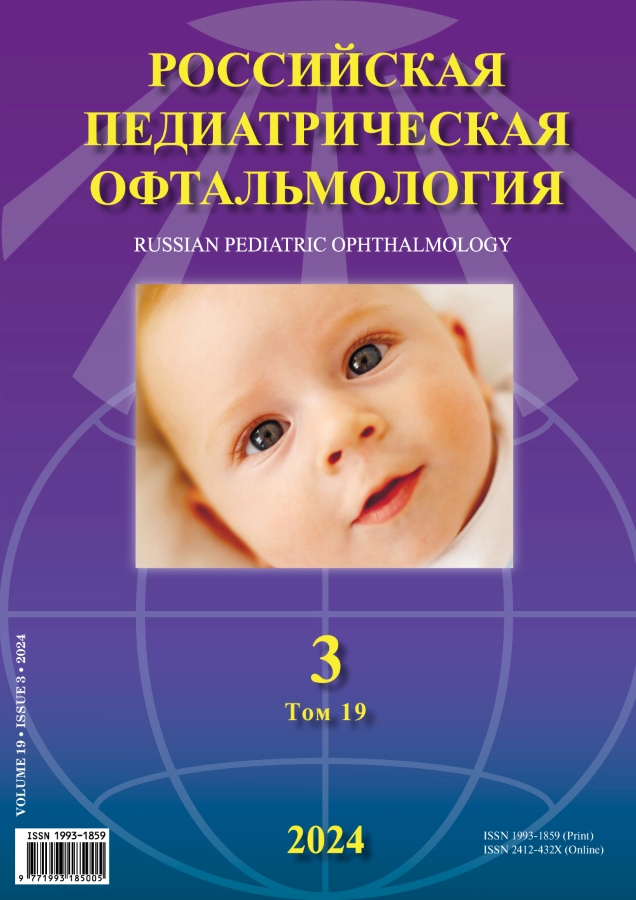Reactivation of retinopathy of prematurity after ranibizumab treatment
- Authors: Revta A.M.1,2, Usynina A.A.2
-
Affiliations:
- Arkhangelsk Clinical Ophthalmic Hospital
- Northern State Medical University
- Issue: Vol 19, No 3 (2024)
- Pages: 161-169
- Section: Case reports
- URL: https://bakhtiniada.ru/1993-1859/article/view/273454
- DOI: https://doi.org/10.17816/rpoj629459
- ID: 273454
Cite item
Abstract
Retinopathy of prematurity (ROP) is one of the most common causes of visual disability in children born prematurely. Intravitreal injection of angiogenesis inhibitors (antivascular endothelial growth factor [VEGF] therapy) is considered one of the conservative methods of treating ROP.
Aim: This study aimed to present a clinical case of ROP reactivation after intravitreal injection of the antiVEGF drug ranibizumab (Lucentis).
MATERIAL AND METHODS: The course of retinopathy in a premature infant with extremely low birth weight was studied.
RESULTS: A patient diagnosed with ROP, a posterior aggressive form of both eyes, received intravitreal injections of an angiogenesis inhibitor at 36 postconceptional weeks. During subsequent follow-up, disease progression was noted, which necessitated repeated ranibizumab administrations to both eyes. Over time, tractional retinal detachment developed in the right eye, and the disease progressed more slowly in the left eye. At the age of 1 year, ROP rapidly progressed to stage 4B in the left eye. Lens vitrectomy was performed sequentially on the right and then on the left eye. At the age of 1.5 years, the patient had coarse preretinal adhesions in the posterior pole of both eyes and had no spatial vision, whereas light perception was preserved.
CONCLUSION: Intravitreal ranibizumab administration for posteriorly aggressive ROP does not exclude its reactivation both early and late after administrations. Further improvement in treatment methods for ROP is necessary.
Full Text
##article.viewOnOriginalSite##About the authors
Andrey M. Revta
Arkhangelsk Clinical Ophthalmic Hospital; Northern State Medical University
Email: andrejrevta@yandex.ru
ORCID iD: 0009-0000-8662-1307
SPIN-code: 3171-7920
MD, Cand. Sci. (Medicine)
Russian Federation, Arkhangelsk; ArkhangelskAnna A. Usynina
Northern State Medical University
Author for correspondence.
Email: perinat@mail.ru
ORCID iD: 0000-0002-5346-3047
SPIN-code: 3735-1100
MD, Dr. Sci. (Medicine)
Russian Federation, ArkhangelskReferences
- Modrzejewska M, Bosy-Gąsior W. Most up-to-date analysis of epidemiological data on the screening guidelines and incidence of retinopathy of prematurity in Europe—A literature review. J Clin Med. 2023;12(11):3650. doi: 10.3390/jcm12113650
- Bhatnagar A, Skrehot HC, Bhatt A, et al. Epidemiology of Retinopathy of Prematurity in the US From 2003 to 2019. JAMA Ophthalmol. 2023;141(5):479–485. doi: 10.1001/jamaophthalmol.2023.0809
- Katargina LA, Trusova SA, Shevernaya OA, et al. The frequency and clinical course of retinopathy of prematurity in modern developmental care conditions as evidenced by the Moscow region perinatal center. Russian Ophthalmological Journal. 2020;13(3):15–20. doi: 10.21516/2072-0076-2020-13-3-15-20
- Kan IG, Astasheva IB, Guseva MR, et al. Medical risk factors and ways to reduce frequency and severity of retinopathy of prematurity in perinatal center modern conditions. Experience of the V.I. Kulakov Obstetrics, Gynecology and Perinatology Research Center of Ministry of Healthcare of the Russian Federation. Neonatology. 2016;14(4):76–82. EDN: XIPNRX
- Revta AM. Features of the course of retinopathy of prematurity in children with a gestation period of less than 27 weeks. In: Proceedings of the scientific conference of ophthalmologists with international participation “Nevsky horizons 2020”; 24–25April 2020; St. Petersburg: Piastre Plus LLC; 2020. P. 283–285. (In Russ.) EDN: BMFFT
- Smith LE. Pathogenesis of retinopathy of prematurity. Semin Neonatol. 2003;8(6):469–473. doi: 10.1016/S1084-2756(03)00119-2
- Sankar MJ, Sankar J, Chandra P. Anti-vascular endothelial growth factor (VEGF) drugs for treatment of retinopathy of prematurity. Cochrane Database Syst Rev. 2018;1(1):CD009734. doi: 10.1002/14651858.CD009734.pub3
- Wood EH, Chang EY, Beck K, et al. 80 Years of vision: preventing blindness from retinopathy of prematurity. J Perinatol. 2021;41(6):1216–1224. doi: 10.1038/s41372-021-01015-8
- Toy BC, Schachar IH, Tan GSW, Moshfeghi DM. Chronic vascular arrest as a predictor of bevacizumab treatment failure in retinopathy of prematurity. Ophthalmology. 2016;123:2166–2175. doi: 10.1016/j.ophtha.2016.06.055
- Huang Q, Zhang Q, Fei P, et al. Ranibizumab injection as primary treatment in patients with retinopathy of prematurity: anatomic outcomes and influencing factors. Ophthalmology. 2017;124:1156–1164.
- Sukgen EA, Koçluk Y. Comparison of clinical outcomes of intravitreal ranibizumab and aflibercept treatment for retinopathy of prematurity. Graefes Arch Clin Exp Ophthalmol. 2019;257:49–55. doi: 10.1016/j.ophtha.2017.03.018
- Bai Y, Nie H, Wei S, et al. Efficacy of intravitreal conbercept injection in the treatment of retinopathy of prematurity. Br J Ophthalmol. 2019;103:494–498. doi: 10.1136/bjophthalmol-2017-311662
- Association of Ophthalmologists; Society of Ophthalmologists of Russia. Federal Clinical Guidelines “Retinopathy of Prematurity” (draft); 2022. Available from: http://avo-portal.ru/doc/fkr/item/446-retinopatiya-nedonoshenny. (In Russ.)
- Chang E, Josan AS, Purohit R, et al. A network meta-analysis of retreatment rates following bevacizumab, ranibizumab, aflibercept, and laser for retinopathy of prematurity. Ophthalmology. 2022;129(12):1389-1401. doi: 10.1016/j.ophtha.2022.06.042
- Patel NA, Acaba-Berrocal LA, Hoyek S, et al. Comparison in retreatments between bevacizumab and ranibizumab intravitreal injections for retinopathy of prematurity: A multicenter study. Ophthalmology. 2023;130(4):373–378. doi: 10.1016/j.ophtha.2022.11.012
- Stahl A, Sukgen EA, Wu WC, et al. Effect of intravitreal aflibercept vs laser photocoagulation on treatment success of retinopathy of prematurity: The FIREFLEYE randomized clinical trial. JAMA. 2022;328(4):348–359. doi: 10.1001/jama.2022.10564
- Wong RK, Hubschman S, Tsui I. Reactivation of retinopathy of prematurity after ranibizumab treatment. Retina. 2015;35(4):675–680. doi: 10.1097/IAE.0000000000000578
- Sidorenko EE. Treatment of retinopathy of prematurity using angiogenesis inhibitors [dissertation]. Moscow; 2022. EDN: AOHKPM (In Russ).
- Zhukova OV, Maltseva IA, Zolotarev AV. Vascular endothelial growth factor inhibitors for retinopathy of prematurity. Russian Journal of Clinical Ophthalmology. 2020;20(4):216–220. doi: 10.32364/2311-7729-2020-20-4-216-220
- Saidasheva EI, Gorelik YuV, Kovshov FV, et al. Experience in the treatment of posterior aggressive retinopathy of prematurity by intravitreal administration of ranibizumab. In: Proceedings of the scientific and practical conference with international participation XVI “Russian National Ophthalmological Forum”. Moscow; 2023. P. 417–419. (In Russ).
- Мintz-Hittner HA, Geloneck MM, Chuang AZ. Clinical management of recurrent retinopathy of prematurity following intravitreal bevacizumab monotherapy. Ophthalmology. 2016;123(9):1845–1855. doi: 10.1016/j.ophtha.2016.04.028
- Yonekawa Y, Wu WC, Nitulescu CE, et al. Progressive retinal detachment in infants with retinopathy of prematurity treated with intravitreal bevacizumab or ranibizumab. Retina. 2018;38(6):1079–1083. doi: 10.1097/IAE.0000000000001685
- Wood EH, Rao P, Moysidis SN, et al. Fellow Eye Anti-VEGF ‘Crunch’ Effect in Retinopathy of Prematurity. Ophthalmic Surg Lasers Imaging Retina. 2018;49(9):e102–e104. doi: 10.3928/23258160-20180907-16
Supplementary files











